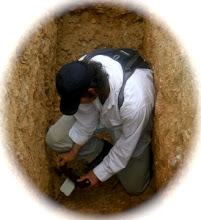A sampling protocol deals with a representative part of the whole. Soil Solutions LLC uses reference samples of 100 cores per sample, generally to a depth of 7 inches. The greater the ratio of the composite: whole, the more accurate the data; and therefore the better we can use the land. Within a single solum we have many variations, and if one population within the series has been allocated for a higher value crop, such as winegrapes, then we must weigh the costs associated with maximizing quality of yield with potential and subsequent increase in profit.
This is known as the Soil Potential Index (SPI), and is governed by $:
SPI = P – CM – CL
In this formula, P is performance, on a scale of 100; CM is an index of the cost of corrective measures; and CL is an index of the cost of the losses associated to a substandard yield. For example, if performance is improved by $1/bottle, at 3 tons/acre, we increase production at $3000/acre/yr. If amendments cost $1000/acre/year, performance is improved and we have a net positive SPI.
The Soil Potential Index has a wide range of variance to generate increased profit margin. With this increased economic threshold, the financial analysis should analyze CL, by comparing the cost of contracting an applicator with the inconvenience of applying soil amendments in-house. Concurrently, CM should be analyzed by comparing various strategies to fulfill vine nutrition. For example, it may be much cheaper and easier to tank-mix soluble iron, than it would be to apply sufficient granular iron to the soil.
The long-term effects of improved soil is not readily apparent. In fact, the future production value of the soils in concert with residual applications may very well greatly exceed expected SPI, to yield increasingly higher quality fruit. The phenomenon of better fruit from improved soils is well-documented. In sum, the propensity to increase the crop’s market value- by augmenting soils and increasing grape quality- by just $1 per bottle, can greatly justify the economic expense if additional cost per acre is less than $3000, at 3 ton/A.
Another intangible feature is that healthy soils promote healthy plants. Healthy plants resist disease much better than stressed plants in dystrophic soils. Increased profit margin can be realized by:
• Reduced rates and/or applications of pesticides
• Reduced cultural practices
o Pruning
o Hedging
o Root pruning
o Cluster-thinning
o Leaf-pulling
• Increased yield
• Increased quality
By applying the philosophy of base saturation, Soil Solutions LLC utilizes the benefits of various reaction mechanisms within the soil. By moderating the base cations (Ca, Mg, K, and Na) in the soil, the grower can better utilize the availability of other nutrients such as sulfur, phosphorous, and nitrogen. As a rule, these soil ammendments (Ca, Mg, K) are much cheaper than fertilizers such as S, P, and N.





